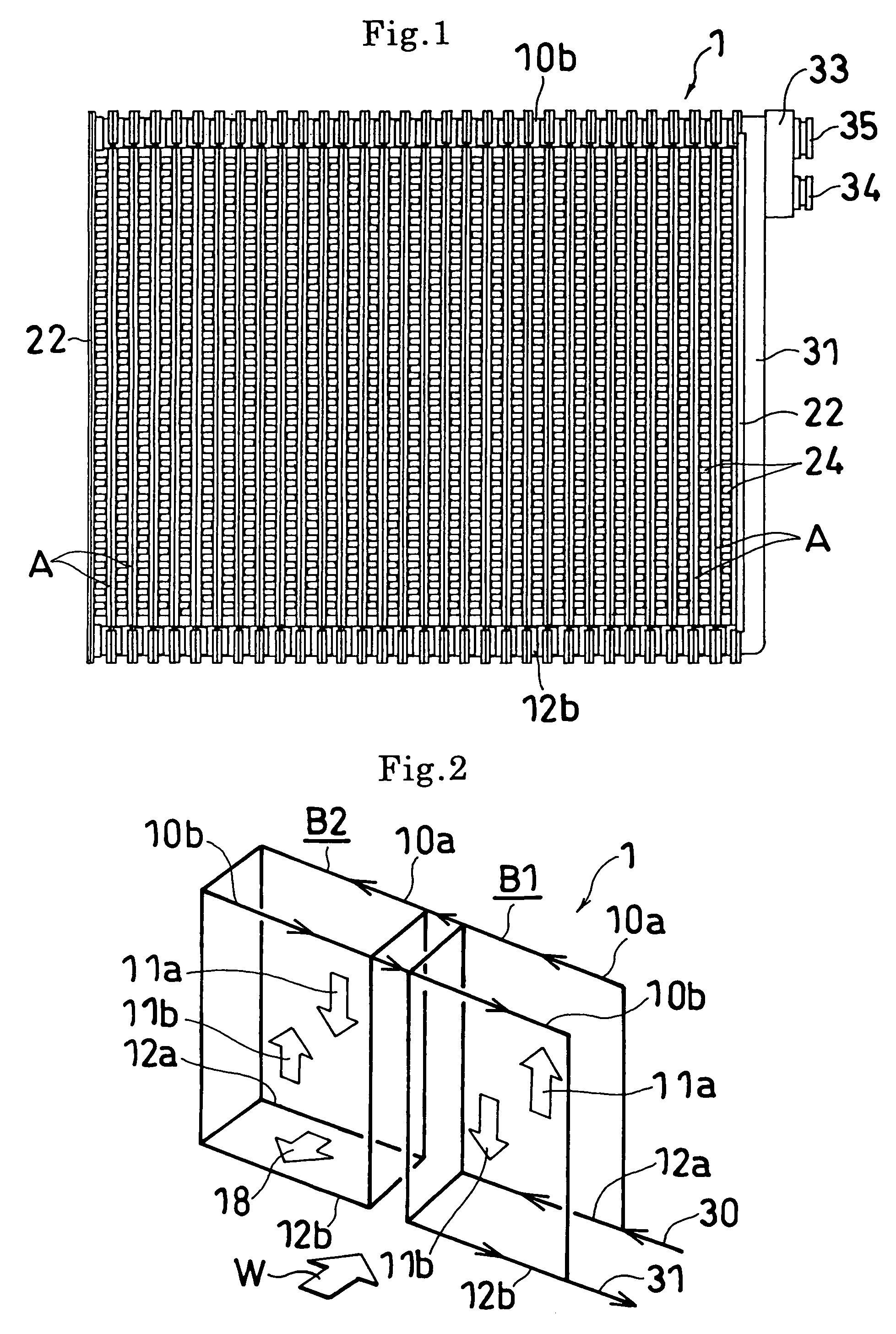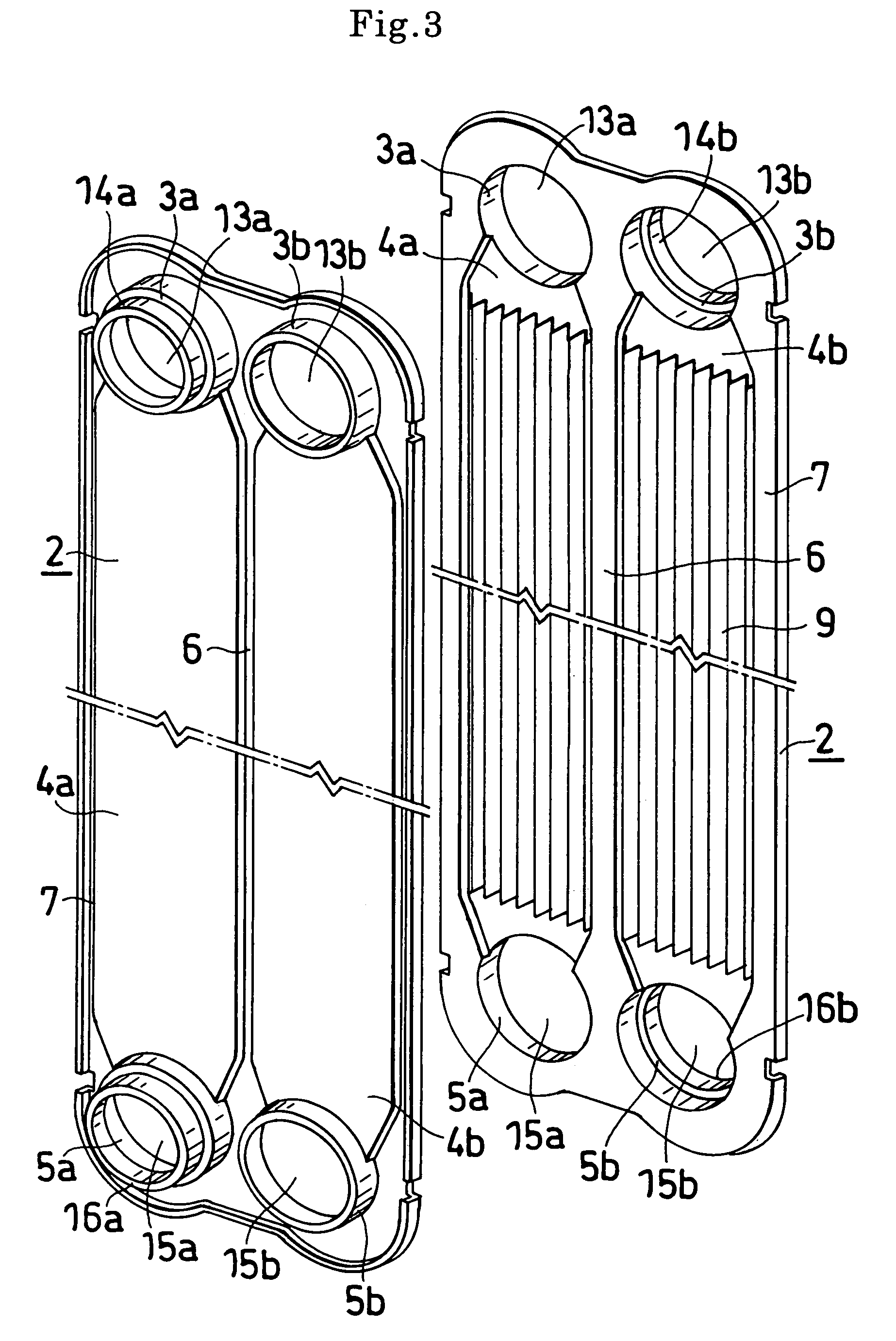Layered heat exchangers
a heat exchanger and layer technology, applied in indirect heat exchangers, laminated elements, lighting and heating apparatuses, etc., can solve the problem of lower side walls, increase pressure loss, and reduce drying
- Summary
- Abstract
- Description
- Claims
- Application Information
AI Technical Summary
Benefits of technology
Problems solved by technology
Method used
Image
Examples
first embodiment
[0047]FIGS. 1 to 11 show layered evaporator of the present invention. First with reference to FIG. 1, the layered evaporator 1 of the invention is made from aluminum (including aluminum alloys), comprises a multiplicity of flat tube portions A arranged side by side, and has a refrigerant circuit which is designed to cause a refrigerant to flow zigzag through the entire interior of the evaporator 1.
[0048]With reference to FIG. 2 showing the first embodiment, the entire assembly of many flat tube portions A is divided into left and right two flat tube blocks B1, B2. Each of the blocks B1, B2 has a plurality of flat tube portions A. The refrigerant circuit is four in the number of passes, causing the refrigerant to flow upward and downward through the two blocks B1, B2 along front and rear flat channels 11a, 11b. In this case, the front side and the rear side of the evaporator provided respectively by the front and rear groups of flat channels 11a, 11b are equal in the number of passes...
second embodiment
[0080]Stated more specifically with reference to the second embodiment, a refrigerant inlet pipe 30 is connected to the front upper tank portion 10a at the right end of the right block B1 of the evaporator 1, and a refrigerant outlet pipe 31 is connected to the rear upper tank portion 10b at the right end of the right block B1. The front and rear upper tank portions 10a, 10b at the left end of the right block B1, and the front and rear upper tank portions 10a, 10b at the right end of the left block B2 adjacent to the block B1 are provided with partition walls 8, 8 (see FIG. 5) and are closed therewith. On the other hand, apertures 15a, 15b (see FIG. 3) for passing the refrigerant therethrough are formed in the front and rear lower tank portions 12a, 12b at the left end of the right block B1, and in the front and rear lower tank portions 12a, 12b at the right end of the left block B2 adjacent to the block B1.
[0081]Furthermore, the left flat tube block B2 of the refrigerant circuit ha...
third embodiment
[0083]FIG. 13 shows the present invention, i.e., a layered evaporator 1 having a refrigerant circuit which is five in the number of passes.
[0084]According to the third embodiment, an assembly of many flat tube portions A providing the evaporator 1 comprises a front half and a rear half which are different in the number of component blocks. The front half of the evaporator 1, which includes front upper tank portions 10a, front flat channels 11a and front lower tank portions 12a, is divided into three blocks B1, B2, B3, whereas the rear half thereof including rear upper tank portions 10b, rear flat channels 11b and rear lower tank portions 12b is divided into two blocks B4, B5. Thus, the front and rear sides of the evaporator provided by the front and rear flat channels 11a, 11b are different in the number of passes. More specifically, the air outlet side provided by the front flat channels 11a is three in the number of passes, and the air inlet side provided by the rear flat channels...
PUM
 Login to View More
Login to View More Abstract
Description
Claims
Application Information
 Login to View More
Login to View More - R&D
- Intellectual Property
- Life Sciences
- Materials
- Tech Scout
- Unparalleled Data Quality
- Higher Quality Content
- 60% Fewer Hallucinations
Browse by: Latest US Patents, China's latest patents, Technical Efficacy Thesaurus, Application Domain, Technology Topic, Popular Technical Reports.
© 2025 PatSnap. All rights reserved.Legal|Privacy policy|Modern Slavery Act Transparency Statement|Sitemap|About US| Contact US: help@patsnap.com



